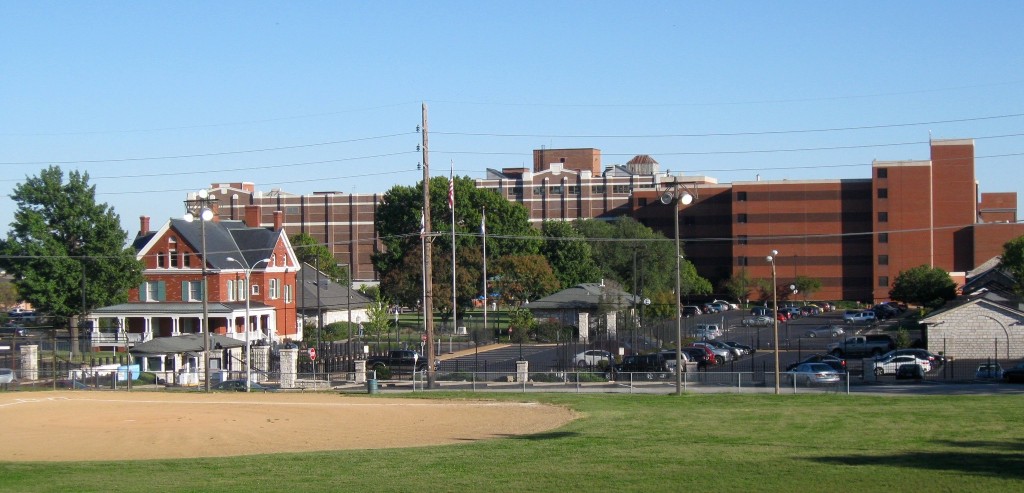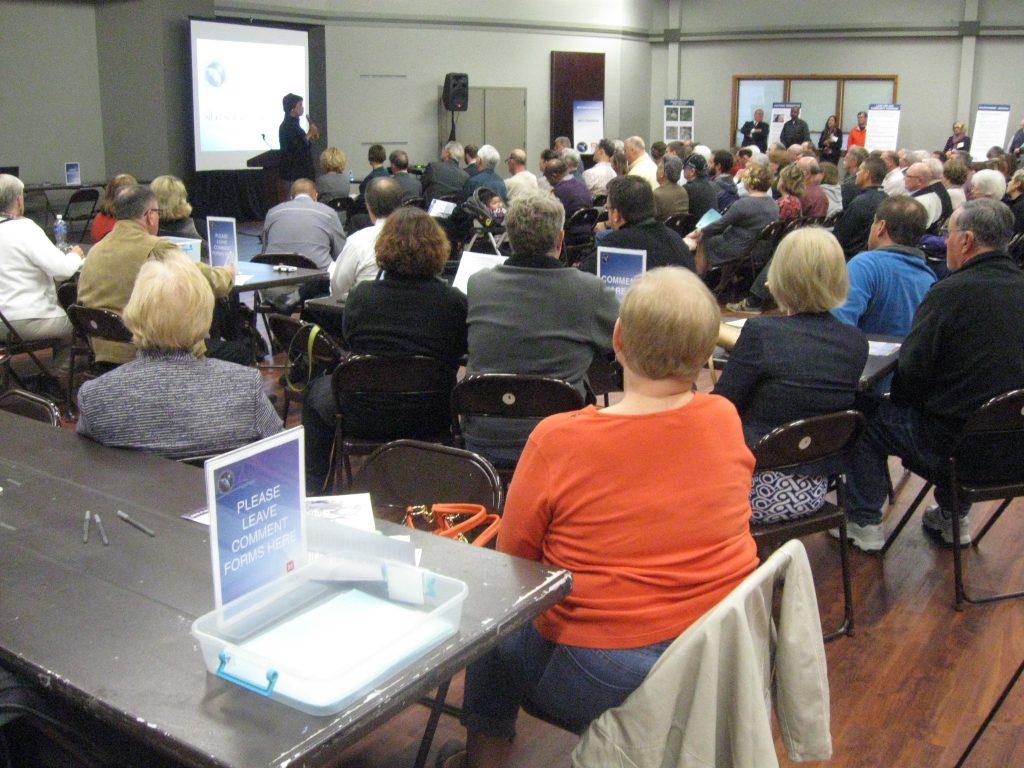Meetings on Geospatial location draw big crowds

By CARL GREEN
Special Correspondent
While many St. Louisans were downtown Tuesday to support keeping the Rams here, the Army Corps of Engineers was launching a series of three public meetings that might have more impact on the region’s future.
The meetings provided information from environmental impact studies and collected attendees’ opinions about where to build NGA West, the new western states headquarters for the National Geospatial-Intelligence Agency (NGA).
The building will be a major construction job in coming years and house about 3,000 well-paid employees once it’s finished.
Interest seemed to pick up each night. On Tuesday, about 80 people came to Crestwood Community Center to hear the presentation and leave opinions. On Wednesday, the Katy Cavins Community Center in O’Fallon, IL, was jammed with more than 150 people hoping the job will go to their state, including several local officials.

Last month, on Oct. 29, about 200 crammed into the Gateway Classic Foundation in St. Louis. Governor Jay Nixon made an appearance to emphasize the importance of NGA West. U.S. Representative William Lacy Clay said the entire Missouri delegation is endorsing the proposed St. Louis site.
The project is to replace the satellite spying agency’s current location at the old St. Louis Armory on 2nd Street just south of downtown, next to the Anheuser Busch brewery. The agency has deemed the sprawling building too expensive to upgrade or rebuild and decided it should instead build a new location somewhere else in the region.
Four sites are being considered – 100 acres at Jefferson and Cass in north St. Louis, 182 acres next to Scott Air Force Base in St. Clair County, 167 acres at the former Chrysler location in Fenton and 101 acres at the Metropolitan Life office complex on Tesson Ferry Road in Mehlville.
In March, a final report is to be issued designating a preferred location, which will then be subject to a final site decision in April, according to the current schedule.
The hearings did not allow for those attending to speak out. Instead they were urged to give comments privately to a court reporter, on a paper form or as an Internet comment.
DECIDING
Susan Pollmann, NGA program director for the project, said the comments will be considered along with all other findings in making the decision.
“It’s an exciting time for us, but it’s also a challenging time,” she said. “I will emphasize that all four sites are in play. Each site is unique, and the Corps will continue the environmental study of each site. We want to see more data.”
Pollmann said the decision will be based on all of the data and several factors including the sites’ potential impact on the NGA workforce, security, cost, scheduling and long-term potential and continuity among them.
“Choosing the right location is absolutely critical for the future of our mission,” she added.
Fenton Mayor Mike Polizzi said at the Tuesday meeting that he and the local Chamber of Commerce have asked St. Louis County Executive Steve Stenger for an explanation of why Stenger endorsed the city site instead of either St. Louis County site.
“All we said was, ‘We don’t understand; can you help us with an answer?’ ” Polizzi said, noting that he has been working with the Corps and NGA. “We’re definitely not out of the running.”
Stenger, in his endorsement, cited regional cooperation. He spoke briefly before the Thursday meeting, saying the city and county are not in competition and that it is important for the jobs to stay in St. Louis.
TAX EFFECTS, JOBS
Information presented at the meeting emphasized and compared effects on land use, tax revenue and predicted the potential for construction jobs.
The biggest tax effect would come if the project is located outside the city of St. Louis. The city now collects $2.19 million a year in local income tax from 3,000 employees at the 2nd Street site, and it would lose that. If the city site were selected, it would instead lose a relatively miniscule $64,180 in annual property tax revenue.
If the project went to St. Louis County, the city would lose its income tax revenue, and in addition, the county would lose property tax revenue – $555,856 at Fenton or $545,495 at Mehlville.
St. Clair County would lose only $32,250 a year if its site is chosen, but St. Louis would still lose its income tax.
The Corps’ forecast for construction jobs is considerably lower than some previous estimates but would still be substantial – 425 new construction jobs, 250 support jobs and 670 additional jobs, for a total of 1,345 “construction related” jobs on spending of $173.7 million.
Corps information also stated that the local construction workforce would do 85 percent of the work and 40 percent of construction materials would be purchased locally.
COMPLICATIONS
At Mehlville, a number of people still working at the Metropolitan Life location, estimated to be in the hundreds, would be displaced, and a natural area on the property could require study or permitting because of the presence of the threatened Indiana bat. Tree clearing could be curtailed.
St. Clair County, too, has a stream and woods that could limit tree clearing, plus a pioneer settlement archaeological site that is on the National Register of Historic Places. The site’s larger size offers flexibility in dealing with these complications, NGA staffers said.
The Fenton site, being a former industrial setting, is relatively free of complications other than that the Meramec River runs along one side. The site, however, is large enough that the Corps is looking at a section of it away from the river. It still has 12 acres in the 500-year floodplain, a Corps staffer said.
The city site, along the north side of Case just east of Jefferson, has the most complications but may also have the most potential for economic development. It is considered blighted and 70 percent vacant. The project would allow for cleanup of contamination and improve public safety, the Corps states. But remaining residents, churches and businesses would be dislocated.
The city site also contains the historic Buster Brown-Blue Ribbon shoe factory, which is on the National Register of Historic Places, plus houses along Montgomery Street that are part of the St. Louis Place Historic District.
HOW TO PARTICIPATE
The Corps of Engineers will accept public comments through Nov. 23 in these ways:
- By mail to U.S. Army Corps of Engineers Kansas City District, attn. Amy Blair, Room 529, 601 E. 12th St., Kansas City, MO, 64106.
- By email to nextNGAwest@usace.army.mil.
- Online at www.nextNGAwest.com/comment.
Please include your identification, any group you may represent and an email address if possible.


Leave a Reply